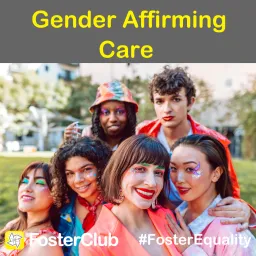In recent years, there’s been an influx in conversations around Gender Affirming Care. As some activists fight to ensure all youth have access to Gender Affirming Care, some states work to end access to Gender Affirming Care. Yet, many people may not know what Gender Affirming Care is or how it impacts LGBTQIA2S+ youth in foster care. We’re here to help you understand both a little bit more!
What is Gender Affirming Care?
- An umbrella term for any developmentally appropriate supports that are proven to reduce anxiety, depression, and suicidal ideation in young transgender and gender-diverse people
- For younger children, this means changing names and pronouns and allowing the child to dress in clothes and wear hairstyles that express their gender
- In adolescents, it includes the above and sometimes may include medical interventions (ie puberty blockers, supportive hormone therapy, etc)
Why Does it Matter to Queer Youth in Care?
Important note: There is very limited data on how gender affirming care specifically impacts queer youth in care. Due to this, much of our data is talking about the general queer youth population, though it is still relevant to queer youth in care.- Transgender and gender-diverse youth in care may want to access Gender Affirming Care
- Providing access to Gender Affirming Car positively impacts queer youth’s physical and mental health1
- One third of transgender youth attempts suicide in a year, data suggests that access to Gender Affirming Care can half that number2
- Some states are seeking to prohibit Gender Affirming Care and, in some cases, investigate families that provide medical intervention Gender Affirming Care to their children. These investigations may lead to a higher rate of LGBTQIA2S+ youth entering foster care
Sources:
1HHS Notice and Guidance on Gender Affirming Care, Civil Rights, and Patient Privacy
2Discriminatory Transgender Health Bills have Critical Consequences for Youth
What can you do?
- Caseworkers + advocates + professionals: Find out your agency’s and state’s laws around gender affirming care. You can also check your state’s “Foster Children’s Bill of Rights,” as some states include protections for LGBTQIA2S+ youth. If your state + agency allows access to gender affirming care, keep a list of LGBTQIA2S+ affirming providers on hand to share with youth who want or need it!
- Kinship Caregivers + foster/resource families: If your youth wants gender affirming care, advocate for them with case workers + professionals. Encourage those on their support team to use their preferred name and pronouns. You can also support your youth by helping them to obtain items that help them express their gender (examples: clothing, makeup).
- Everyone: Find out what organizations in your community provide gender affirming care to youth and offer them your support through volunteering, finances, or helping to connect queer foster youth in your life to their services.
- You can also contact your representatives and senators and tell them to protect gender affirming care! Urge them to pass laws that protect gender affirming care from ever being prohibited and encourage communities to have access to gender affirming care. Make sure to tell them how important access to gender affirming care is to LGBTQIA2S+ youth in foster care!
Find additional resources below:
- For a brief overview on different types of gender affirming care, see Gender Affirming Care and Young People
- For information on how gender affirming care impacts mental health, read The Trevor Project Research Brief: Gender-Affirming Care for Youth
- For more information on Gender Affirming Care and its impact on LGBTQIA2S+ youth, read the brief by Child Trends: Discriminatory Transgender Health Bills have Critical Consequences for Youth
- For more information on how policies hindering Gender Affirming Care can impact LGBTQIA2S+ youth in care, read this statement from FosterClub: FosterClub Believes Transgender and All LGBTQ2S+ Young People in Foster Care Deserve Safety, Affirmation, and Love
- The Government Accountability Office (GAO) released a report on Further Assistance from HHS Would be Helpful in Supporting Youth's LGBTQ+ Identities and Religious Beliefs. The report includes perspectives and insights from FosterClub Lived Experience (LEx) Leaders
- Statement by HHS Secretary Xavier Becerra Reaffirming HHS Support and Protection for LGBTQI+ Children and Youth
- The Information Memorandum from the Administration for Children and Families (ACF) provides information on how best to serves LGBTQI+ children and youth in the child welfare system
- Alongside the Information Memorandum, Associate Commissioner Aysha Schomburg released A Message in Support of LGBTQI+ Children and Youth Who Are Involved with the Child Welfare System



